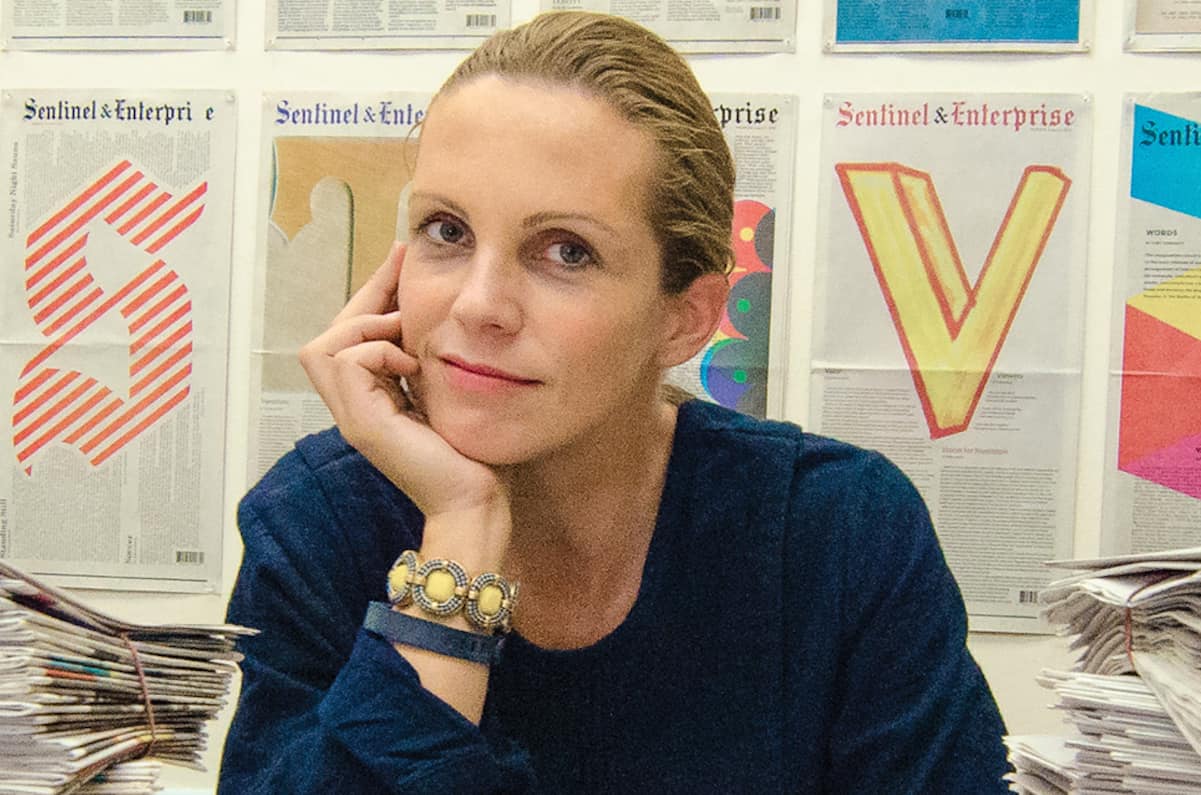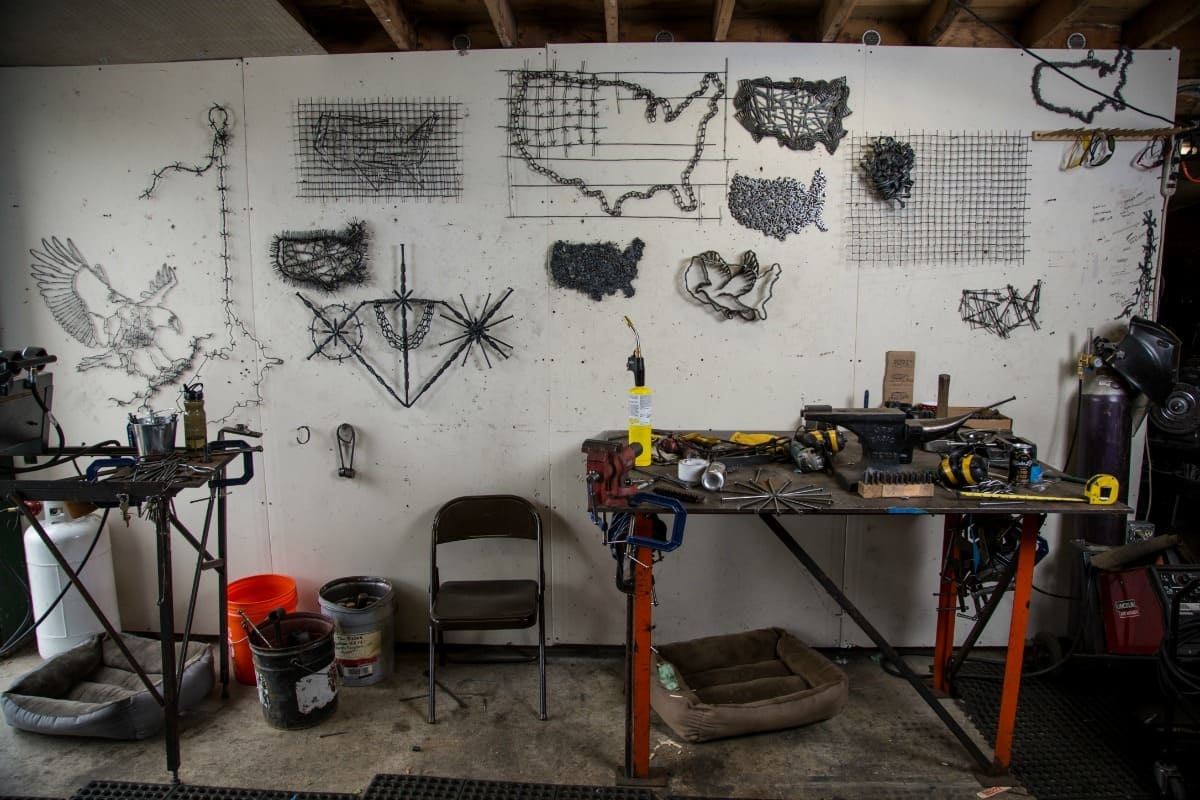Anna Haber’s inspiring story involves abandoned mental hospitals, the alphabet, and an enormous bouquet.
Editor’s Note: If you just heard about the artist ANNA SCHULEIT HABER, it’s probably because of what she did on her summer vacation. She spent a month in Fitchburg, Massachusetts, a former mill town not at all on the art literati’s radar, conducting a friendly takeover of the front page of the local newspaper with imaginative typography. The MacArthur Fellow collaborated with the Sentinel & Enterprise and the Fitchburg Art Museum on a project that involved turning 26 consecutive editions of the daily newspaper into a work of art centered on a letter of the alphabet. Typographers from all over the United States and the world created the letters, which dominated their respective front page and informed articles, essays, poems, and quotes that riffed off the A, G, Q, etc. The whole thing was stunning, subversive, and accessible—a profound celebration of ink and newsprint, journalistic experimentation, and bringing art to people’s everyday lives.
While Schuleit Haber worked on The Alphabet, fellow artist Nanette Vonnegut wrote this essay about Schuleit Haber’s body of work—from years-in-the-making installations at abandoned hospitals to paintings to musical compositions— and the connections between the two artists and Vonnegut’s late father, Kurt.
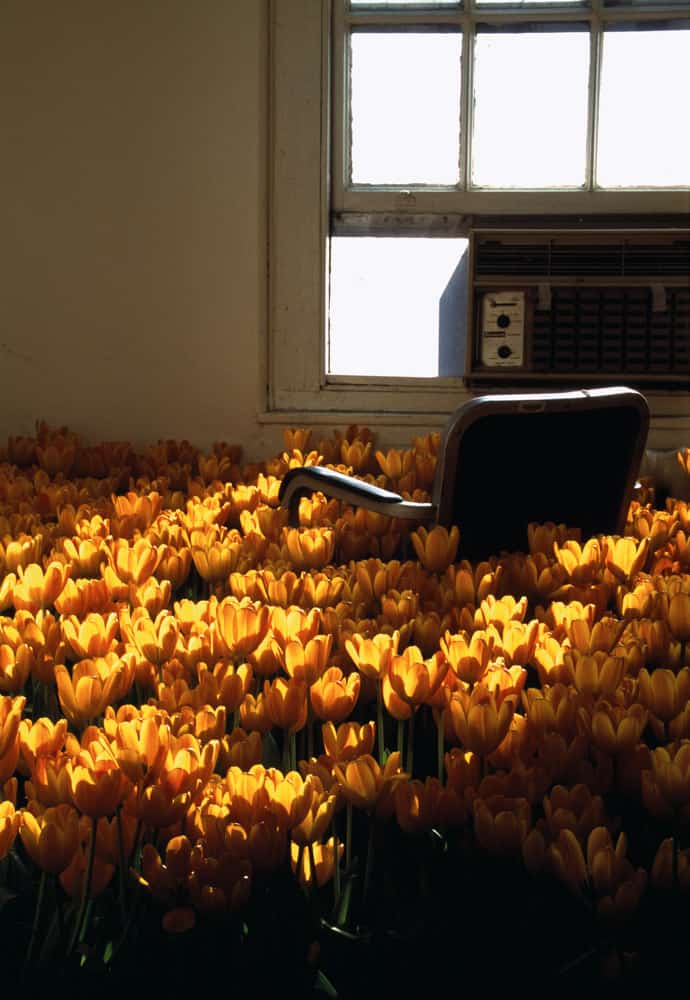
Orange Tulips, 3rd floor. Installation, titled Bloom, of 28,000 flowers in bloom and 5,600 square feet of live sod. Massachusetts Mental Health Center, Boston, 2003. Commissioned by Harvard Medical School and the Department of Mental Health of Massachusetts.
It is mid-November 2000. I am in the laundry room, trying to match socks and feeling hopeless. Just when I want to scream, I hear in the distance J. S. Bach’s Magnificat, like a musical thunderstorm close by. My husband reminds me that an artist named Anna Schuleit is doing a soundcheck for a sound installation called Habeas Corpus, to take place the next morning at the grounds of the Northampton State Hospital.* As the crow flies, this place is just a mile away, over houses, gentle hills, and a field or two. I am beguiled and want more of the magic that is rattling my doors.
Besides the socks, I have my hands full because my father is visiting from New York City. He is grumpy because Northampton is not New York City. Now I know I have something special to show him. “Dad, I’m taking you to something magical in the morning. Wear a hat.”
The next morning, I fetch my father and he is bundled up against the cold, gray day. He did not forget to wear his stocking hat, which is on crooked, making him look more curious than grumpy. There are hundreds of people gathering, milling around, gazing in anticipation at the massive vacant brick building, Old Main, that once housed adult men and women deemed insane. It was enough to be poor, or old, or a wife who had stopped being useful around the house to get a spot at the Northampton State Hospital.
I am thinking of these men and women when the condemned building and the air around it quicken to the sounding of trumpets and timpani. The perfectly engineered panoply of sound has entered the marrow of my bones and somehow not busted everything along the way. The crowd is a pulsing cloud of humanity, slowly drifting around Old Main. No one dares to peek in the doors and windows to look for the source. As if on cue, the sun parts the concrete-like clouds and pours straight into the heart of Old Main. It is over in 28 minutes. I am wondering if my father is thinking of the destruction of Dresden or of his mother’s sudden death right before he shipped off to war. I do know he is deeply affected. “I can’t believe what just happened,” is all he says.
At the root of a lot of art is some kind of injury that needs addressing. Sometimes the right strand of words or a line drawing of someone you miss will do. The decades of neglect and acres of broken human hearts that came to define hospitals like this one, however, called for 40,000 watts of electricity conducting carefully selected music through 15,000 feet of electrical cable and 102 speakers amid thousands of square feet of brick and mortar. Anna envisioned that “the sound [would] travel through past and present times in one breathtaking, effortless movement.”
I did not know it then, but it was my two dead grandmothers who were rattling my doors as I wrestled with those socks. Since then, I have been digging for information, coroner’s reports and medical records, to try and fill the vast blanks in their lives. No luck with Grandmother, whom I never knew, but medical records for Granny, whom I did know, arrive by mail. Granny was institutionalized twice in a state hospital much like Old Main—once in 1943 for 12 months and again in 1953 for 6 months. The order of commitment allowed for sexual sterilization, citing “the best interest of society.” Maintenance cost: $10 per week. The medical records note: “Manic Depressive Reaction, Manic Type . . . was high school Valedictorian, unusually able in literary matters, particularly writing . . . Lesbian tendencies.” I weep. She got out and went on to be the most boring, sweet-smelling Granny ever.
As for Grandmother, I found a brief obituary in the Indianapolis Star: “Suffers Fatal Heart Attack.” Of course that is code for “not exactly sure since barbiturates and alcohol were involved.” She died on Mother’s Day, that stingy, cruel day that reminds mothers of the other 364 days they will not get any flowers. A message to mothers everywhere: try not to die on Mother’s Day. It is a seriously bitchy thing to do to your children. But it is easy for me, a mother, to understand the extra swig, another pill, knowing my son is being sent off to war.
After Habeas Corpus, Anna went on to complete more site-specific installations in New England. Bloom took place in 2003 in a vacated psychiatric hospital in Boston: 28,000 blooming plants, 5,600 square feet of live sod, water, volunteers, and recorded sound for four days, for FREE, “to address the persistent absence of flowers in psychiatric hospital settings.”
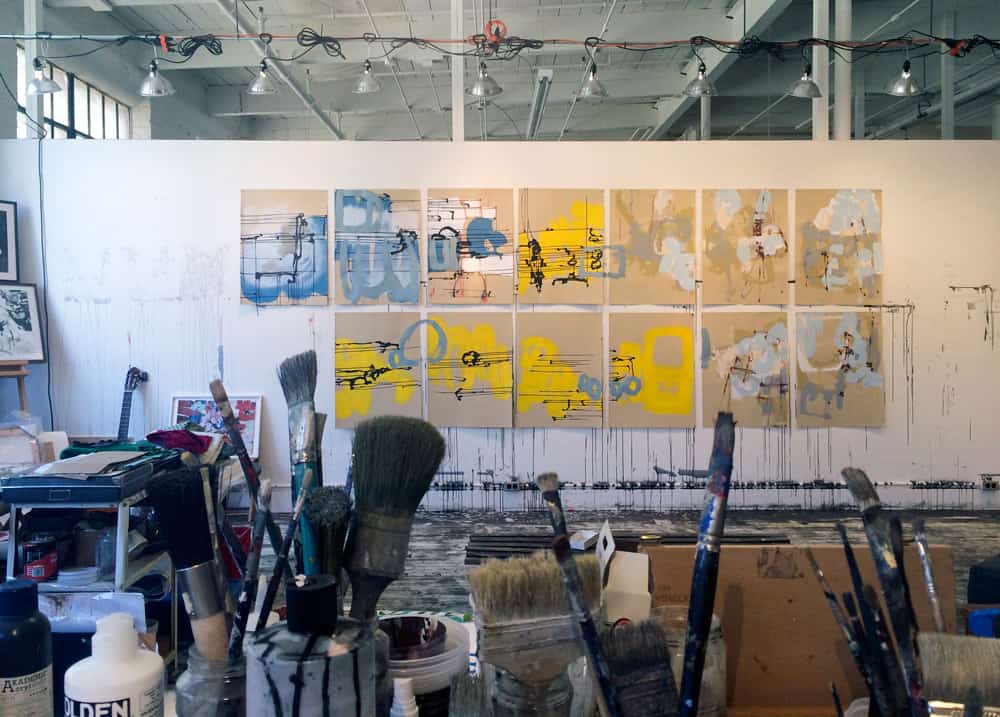
Anna Schuleit Haber’s studio
Even pixilated, the images of Bloom uncoil my tense little heart. Anna’s unstinting use of flowers to fill yet more vacant, grief-stricken spaces was exactly what was necessary, nothing less. I felt electrified in a familiar way as I studied photos of Bloom. The power of the visual matched the power of the sound that marked Habeas Corpus. Anna never puts herself at the center of her installations. Her large, beneficent visions have always depended on the generosity of others, making the installations a collaborative effort. Habeas Corpus gestated for four years and nearly died for lack of funds and support before finally coming to life. At first, Anna’s idea for Bloom was met with disappointment because she could not see repeating Habeas Corpus at the Massachusetts Mental Health Center in Boston. Visions need to spontaneously combust in others to see the light of day. Whether in a day or years, Anna’s ideas caught on and set off a chain reaction of generosity in others that finally made the concepts live and endure as works of art. No one is more humbled by this creative process than Anna Schuleit Haber.
The MacArthur Foundation, angelic and moneyed, looks for and funds exceptionally creative, pathbreaking individuals. On September 1, 2006, the director of the program called Anna, then 32, to let her know she met every single qualification to be a MacArthur Fellow and that she was already making the world a better place, citing her installation Bloom as “a work of conceptual clarity, compassion, and beauty.” The award comes with no strings attached. No person getting that call from the MacArthur Foundation sees it coming; he or she is usually on the way to work, taking a bath, or paying bills. This is a phone call the Fellows will never forget. The media calls the fellowship the MacArthur Genius Award, because it is easier to say genius than to list qualities like transcendent, brave, tenacious, and compassionate. I Google “genius,” and nothing about hard work or compassion shows up. Genius seems to be a word that is in love with itself and does not do anything.
Thanks to the MacArthur grant, Anna could afford to be in her studio full time for the first time in her life. She returned to her first love: painting. Her drawings and paintings show us where she has been, always saying, “Human being here.” She employs 200 brushes and no two are alike. One could say of Anna’s work that there is always just one of one, which can lead to 2 or 2,000. Her work looks as though her whole body is moving through it. I see long strides, stillness, and maybe some tap dancing. Her work stands in direct proportion to life, which, in her case, sometimes requires the side of a building or 25-foot panels of raw linen.
As I write this, I find myself feeling dizzy because I know I cannot cover the breadth of Anna Schuleit Haber’s work. Luckily, I have a fainting couch in my studio. I like to think I am being useful, fainting by proxy for artists like Anna so they do not have to. I am grateful for all the heavy lifting she does without complaint.
My father did not love to write. It was mostly torture, a lot of sitting and failing and foraying into the kitchen for fatty snacks, a cigarette always stuck to his bottom lip. When I write, I feel very close to him—I am wearing a bodysuit made of twigs and twitching more than actually writing. But if you are patient, there comes a magic pairing of will and muse: a beloved sister, a wretched boyfriend, a Granny. They make the waiting worthwhile. Then a word, a brushstroke, a song, a cure, the best joke ever. Both Anna and my father remind me about staying and not leaving.
The Voice Imitator, started in 2013, is a work in progress, a collaboration involving the written word, musical composition, and paint between two artists who happen to be husband and wife. My mouth waters as I read the proportions of the work: one short story to one composition for piano to one painting, 1:1:1, which is multiplied by 104, the number of short stories in Thomas Bernhard’s 1978 collection, Der Stimmenimitator. Bernhard’s words move through Anna’s voice; are transmuted into short musical compositions by her husband, composer Yotam Haber; and are then sent back into Anna’s brave and able hands. This much information passing through two human bodies, winding up as art, is explosive and seriously playful.
Effective is the most useful, unsexy word I can come up with to describe what I think art, at its best, can be. What I experienced years ago at Old Main effectively challenged and changed me. I was witness to others changing around me. I felt ghosts brushing by me, going home and not looking back. Anna’s Habeas Corpus really did move the Magnificat through me, and the past into my future. I stand in awe of the veracity of her visions and her conductive powers.
In response to my introductory e-mail, in which I explained that I had been at Habeas Corpus with my father, Anna wrote, “The short of the story is that people told me that your dad was there that day, but it was just a rumor. It means so much to me . . . I was (and still am) such a big fan of his work. Having the circle close by getting to know you fifteen years later is a true gift.”
On a perfect June day, I met Anna at last in Harrisville, New Hampshire, where she spends her summers. As I sat waiting on the front porch of the Harrisville General Store, I explained to a curious elderly gentleman that I was meeting a dear old friend whom I had never met. He must have noticed my flapping wings. Suddenly, I was looking up into Anna’s open, intensely lovely face. Our words looped around our heads and played a gentle game of tag while we ate our lunch on that porch. There was so much catching up to do; there were so many stories to finish. Anna explained how much my father’s writing had affected her life. Sitting with her, I was struck by her radiant kindness, the key ingredient that arcs through all her work— what makes it stand so tall. The circle was complete and round with love and respect for the art that had saved our lives in countless ways. Three hours later, it was time to go.
Finally, Anna Schuleit Haber, meet Kurt Vonnegut. Dad, meet Anna. I can easily imagine my father asking Anna to run away with him and Anna answering, “I have always loved you, but I am married.” Then my father: “Teach me how to paint.” Anna: “You have to do that on your own, but stay and watch how I stay.” My father: “Darling, I have never left!”
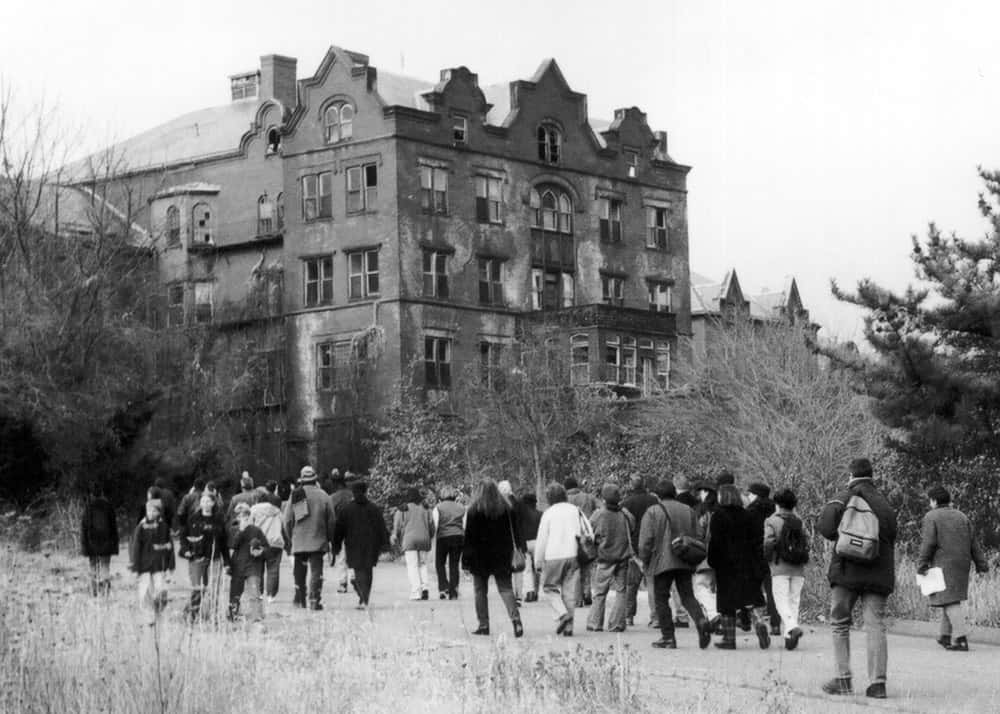
Habeas Corpus, a sound installation for Northampton State Hospital. | Photo by Hedwig Schussler
Anna Schuleit Haber – artist
Harrisville, New Hampshire
Website
Facebook
Twitter
Instagram
Top photo by photographer Ashley Green

